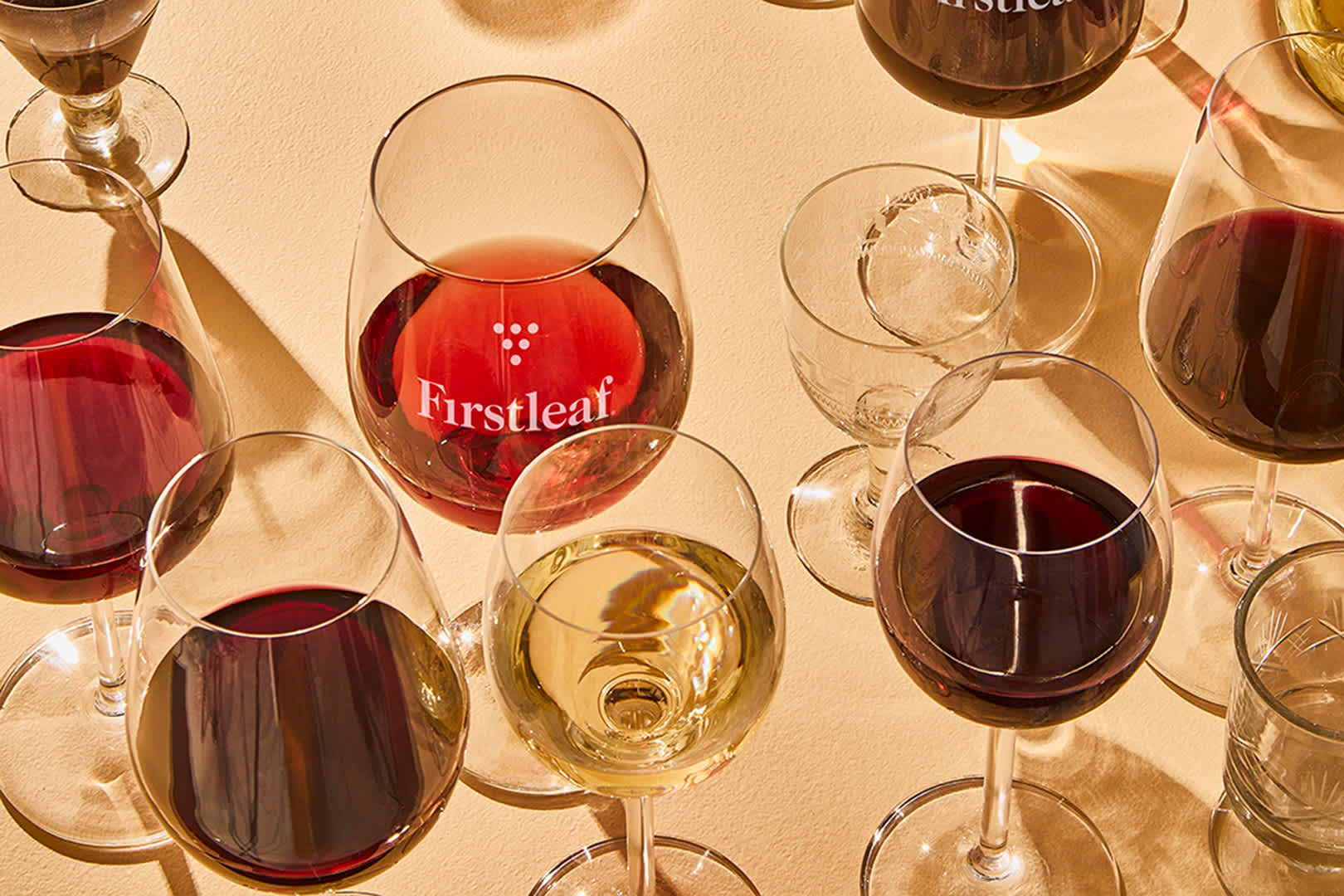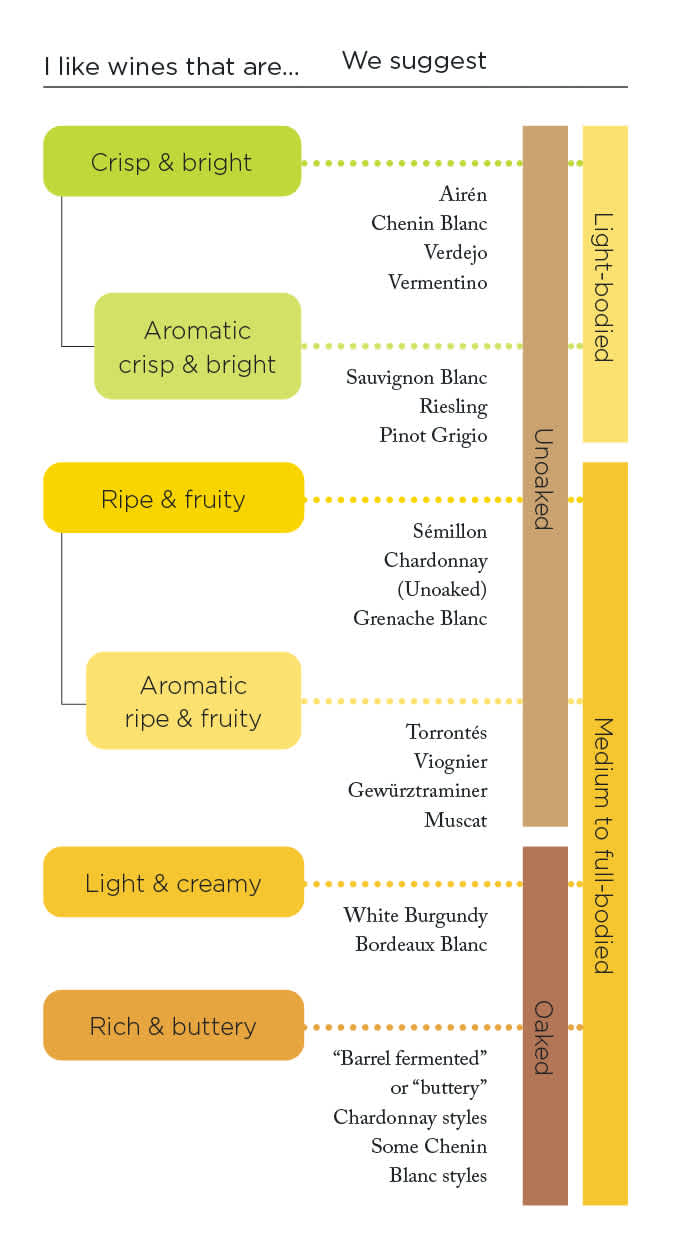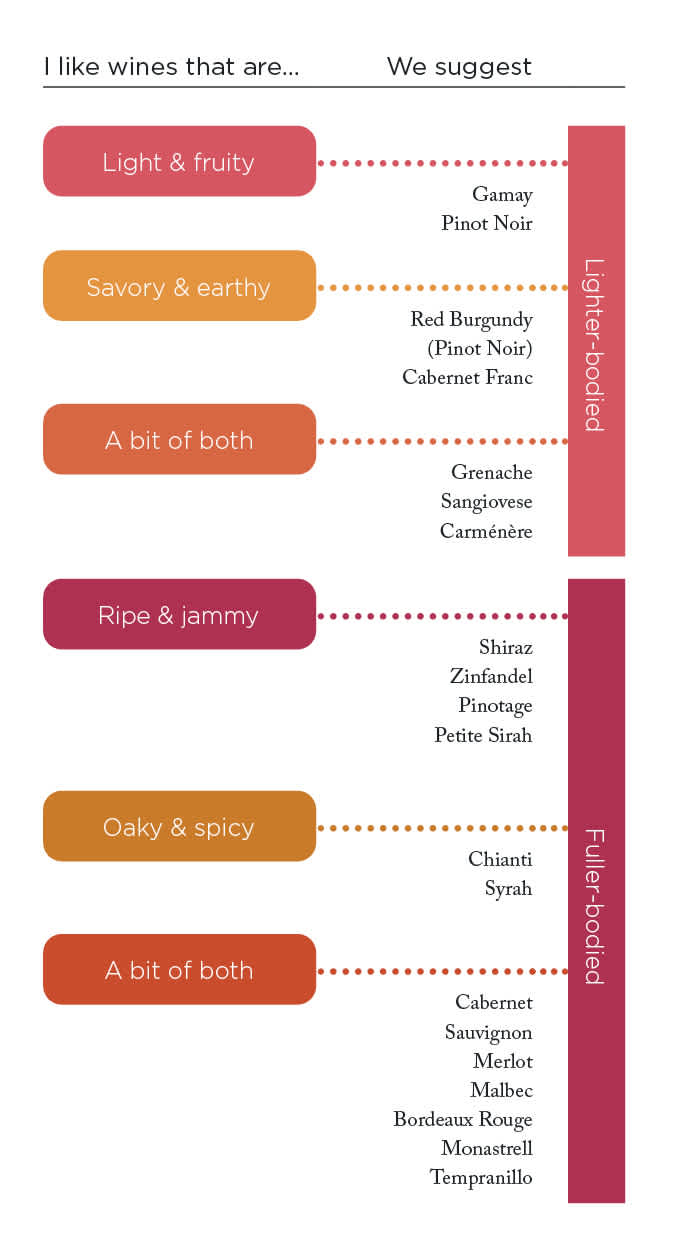Firstleaf's Guide to Wine Styles
Explore the styles of wine and discover your personal preference
The wine world is full of flavor. With over ten thousand grape varieties, a multitude of growing regions and countless wine styles, it has something for everyone. While impressive, this diversity can seem overwhelming when picking a bottle. We've designed two easy-to-follow exercises to help identify your flavor preferences and explore the types of wine that match. Some you will recognize, and some you'll leave eager to try.
IN THIS ARTICLE:
Want personalized wines?
Get your first box of wines for $44.95 + free shipping.

White wine styles
White wine lovers start here. Pick the category on the left that you connect with most; next to it, you will find the types of white wine that commonly fall into that style. Read about your selections below.
Crisp and bright
These wines are light-bodied, with upbeat fruit flavors, mouthwatering acidity and minerality. These wines are usually made from grape varieties that are naturally high in acidity. They commonly feature citrus, tree fruit, green fruit, underripe stone fruit or mineral notes and make excellent selections for food pairing due to their refreshing nature.
Crisp and bright: aromatic
In addition to being light-bodied with crisp textures like the styles above, these wines are made from grape varieties that are known for exceptionally intense aromas. These aromas jump out of the glass and can range from fresh herbs and flowers to perfumy and exotic.
Ripe and fruity
These wines are often fairly light to medium-bodied and have prominent fruit flavors. They feel heavier on the palate than crisp and bright styles and have plusher, juicier textures. Though they can share similar aromas and flavors to lighter styles, their notes lean riper in character and more flavorful. For example, a crisp and bright white wine style may show notes of tart nectarine, whereas a ripe and fruity white wine could have notes of plump yellow peaches or even tropical fruit.
Ripe and fruity: aromatic
Like their lighter-bodied counterparts, these ripe and fruity wines are typically made from naturally aromatic grape varieties. Their aromas often feature notes of florals, ripe citrus, exotic tropical fruit, and sometimes honey or spice, depending on the grape variety.
Light and creamy
White wines fermented or aged in oak have fuller, softer textures than those fermented in stainless steel. Oak can also add spicy notes like vanilla. Using oak is a stylistic choice made by the winemaker. These white wine styles still offer fruity characteristics alongside their oak-driven complexity and feel soft and creamy on the palate.
Rich and buttery
The longer a wine ages in oak or the newer the barrel, the more intense its "oaky" character becomes. These wines will feel heavy and round on the palate with layers of rich, oak-driven characteristics (e.g., caramel, nuttiness, spice). At this level, oak is often used in combination with malolactic fermentation. This is the winemaking process that creates notes of butter or cream in white wines by naturally converting sharp-tasting malic acid into softer lactic acid.
Red wine styles
Red wine fans, this next image is for you. Pick the category on the left that you connect with most; next to it, you will find examples of red wine types that commonly fall into that style. Read about your selections below.
Light and fruity
These are typically light-bodied, fruity red wines with bright acidity and light tannins. Their aromas and flavors can range from fresh red or dark fruit to candied fruit or even bubblegum, depending on winemaking techniques. They typically won't show any oak-driven notes; if they do, they are greatly outshone by fruit.
Savory and earthy
These wines are light to medium-bodied with subtle tannins. Savory elements often rule their flavor profiles. Winemakers can emphasize savoriness over fruit flavor by harvesting sooner to capture herbal aromas or aging in oak to add spice notes. These wines' aromas and flavors feature prominent herbal, earth, spice or oak-driven characteristics with mild fruit intensity.
A bit of both: lighter-bodied
These light to medium-bodied red wines balance fruit flavors with savory or oak-driven characteristics. The ratio of fruity to savory elements ranges depending on style. Some examples of common aromas and flavors in this style include herbal, earth, spice, red fruit or dark fruit notes.
Ripe and jammy
A jammy red wine is rich and full-bodied, with exceptionally ripe fruit flavors. They feel heavy on the palate with plush textures. Some common aromas and flavors include jam-like red and dark fruit, fruit preserves, baked/stewed fruit, or dried fruit.
Oaky and spicy
These are fuller-bodied red wines with fruit notes that fall secondary to oak-driven characteristics. This can result from extensive oak aging, heavily charred oak barrels or a grape variety with inherently spicy notes (e.g., Syrah). The older the wine, the more likely it will fall into this category, regardless of varietal. Common oak or age-driven notes include baking spice, clove, toast, espresso, leather and tobacco.
A bit of both: fuller-bodied
Many red wines fall into this category. They can be described as fruity and oaky, meaning they are fruit-forward with notable oak-driven characteristics that add to the wine's complexity. They usually have a fuller body with structure created by high acidity and tannin levels. The ratio between fruit and oak-driven elements can vary by style and winemaking techniques.
What influences wine style?
Grape variety
Wine grapes are incredibly diverse. Each varietal has an inherent set of natural aromas, flavors and structural characteristics. Some grape varieties naturally lend themselves to a certain wine style, for example, crisp and bright Sauvignon Blanc. Others could qualify for multiple and be guided in one direction or another by winemaking, for example, rich and buttery styles of Chardonnay.
Winemaking techniques
Winemaking influences a wine's flavor profile. The degree of that influence is up to the winemaker. Some styles of wine highlight the varietal's natural characteristics, meaning winemaking will opt for materials and techniques that don't impart flavor, like fermenting the wine in stainless steel instead of oak. Some styles rely on winemaking techniques, most commonly oak which creates complexity in light and creamy, rich, buttery and spicy wine styles.
Climate
Grapes from cool climates have less access to sunlight and heat than warmer climates, meaning cool-climate wine styles will naturally have a lighter body and higher acidity. White wines from cool climates can easily fall into the crisp and bright categories, whereas warmer climate examples will lean ripe and fruity. Red wines from cooler climates will have a brightness to their character with fresh red or dark fruit notes. They can be light and fruity or have some oak-driven notes, whereas warm climate examples will often lean more bold with rich dark fruit or even jammy characteristics.
Vintage
While climate remains consistent from year to year, weather during the growing season can vary. Unexpected high or low temperatures and storms have the potential to affect ripening which could make the wine cross the threshold of a new style. For example, an end-of-season heat wave could accelerate ripening, pushing a fruit-forward Cabernet Sauvignon into the ripe and jammy territory.
Why does wine style matter to me?
As we mentioned before, the wine world can be a confusing place. Wine styles are an easy way to learn what you like and explain your preferences without memorizing the famous châteaux names or the unique characteristics of over a thousand grape varieties. Check out our WinePrint™ for an even simpler way to learn about your wine preferences and identify your personalized taste profile.
IN THIS ARTICLE
Want personalized wines?
Get your first box of wines for $44.95 + free shipping.


WinePrint™ by Firstleaf
Are you looking to learn more about your wine preferences? Check out our Wine Print for an in-depth look at your personal tasting profile. Discover your favorite wines, varietals, regions, and tasting notes and get personalized recommendations wherever you are.
Learn More

